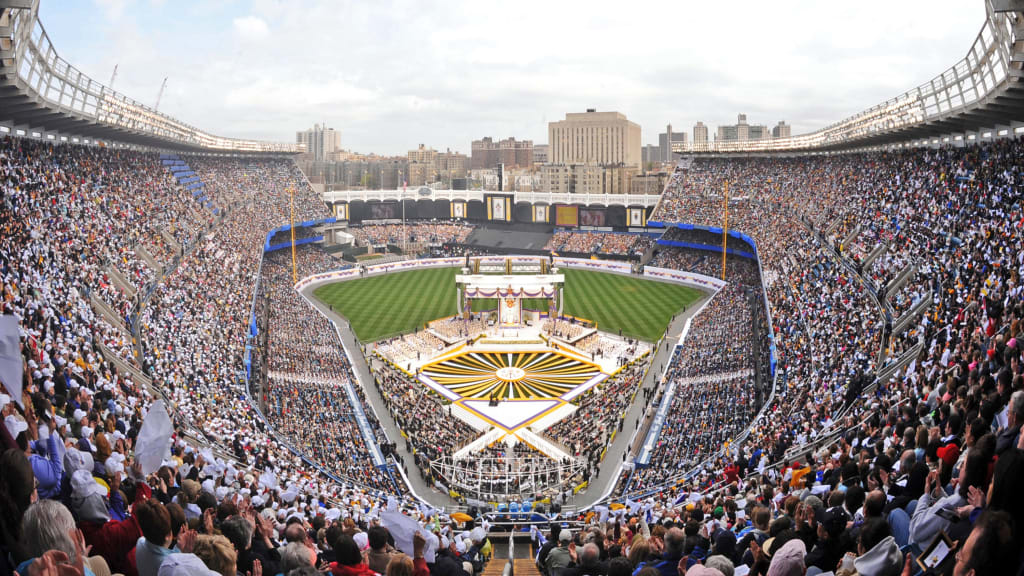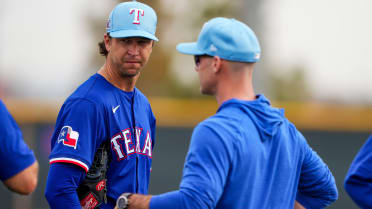Yankees Magazine: A Place for Heroes
There is more to Monument Park than the legends of Yankees lore

Directly in the center of Monument Park stand the monuments dedicated to some of the most famous names in baseball: Babe Ruth, Lou Gehrig, Miller Huggins. Behind those are two more greats, Mickey Mantle and Joe DiMaggio. These are men who defined the sport for generations -- heroes of the game, to be sure.
Through their contributions to baseball and the Yankees over many years, each man earned the right to be remembered -- to have fans of the game presented with his greatness in the form of a monument. But the space out past center field isn't reserved solely for those who represented the interlocking "NY." Not all heroes wear pinstripes.
New York City has been the site of innumerable events, celebrations, triumphs and tragedies. And Yankee Stadium has provided a stage befitting its city for many of them. Between all the baseball and football, soccer and boxing, the Stadium has opened its gates to popes, world leaders and citizens of a grieving nation. Just like the hundreds of museums and galleries throughout the five boroughs where history, art and culture converge, there is a spot at Yankee Stadium to reflect on the major moments that transcended baseball.
Down the path from a wall adorned with plaques commemorating each of the three papal visits to the Stadium sits one of the largest monuments in Monument Park. Standing alone, the solemn monument is dedicated to the men and women who lost their lives during the tragic events of Sept. 11, 2001, as well as to all those brave souls who sacrificed so much in the aftermath of the attacks.
And just off to the left of that monument, on the wall next to a plaque honoring Jackie Robinson, hangs a large plaque dedicated to Nelson Mandela, a selfless and devoted world leader who visited Yankee Stadium in 1990 to deliver his message of peace.
It's interesting, the juxtaposition. And it's worth noting the similarities of the tributes. Mandela endured horrific treatment, suffered immense hardship. The 9/11 attacks were tragic on a scale the world was unaccustomed to and ill-prepared for. But Mandela rose from his circumstances to inspire. And in the ashes of death and destruction, regular Americans found inspiration to show the compassion and resilience of a nation. These are people who defined human decency for generations -- heroes of the world. And, both because of and despite their connections to the Yankees, they both transcend and epitomize the spirit of Monument Park.
"The Yankees organization, and Yankee Stadium, especially, symbolizes so much more than just a baseball organization," says Brian Richards, the senior museum curator at Yankee Stadium and a baseball historian. "It's so much more than just 27 championships. This is a symbol of excellence, of success, of what America is capable of. [The Mandela plaque and 9/11 Monument] I think show the significance of Yankee Stadium on a national stage and on a world stage. It shows that this is far more than just a venue for athletic competition. This place is a symbol of New York City, and this is a symbol of what the Yankees represent for the entire country."
Yankee Stadium -- and by extension Monument Park -- has been given any number of nicknames. From The House That Ruth Built to the Cathedral of Baseball, no matter the moniker someone uses to describe the Stadium, the ballfield always comes to mind. But, to Richards' point, the home of the Yankees has come to symbolize so much more than just America's pastime.
From the first papal Mass in 1965 to Mandela's visit in 1990 to the interfaith ceremony following the events of Sept. 11, Yankee Stadium has played host to grand and historical proceedings that have absolutely nothing to do with baseball. And the choice of venue was no coincidence.
"I think it's significant that Mandela did speak at Yankee Stadium," Richards says. "Could he have spoken at Cleveland Municipal Stadium? I'm sure he could have. It had a bigger seating capacity. Could he have spoken in Kansas City or Atlanta or Seattle? Sure, he could have spoken at any of those places. But the fact that he spoke in New York, and at Yankee Stadium, at this universally recognized cathedral of excellence, I think there is significance there."
Mandela wasn't the first to recognize the significance of Yankee Stadium, and he certainly wasn't the last.
In the days after Sept. 11, Rudolph Giuliani, then the mayor of New York City, reached out to Yankees principal owner George Steinbrenner and asked if he would be willing to open Yankee Stadium to the people of New York -- and to the eyes of the world -- to host an interfaith ceremony billed as "A Prayer for America." Steinbrenner agreed, and it became a moment in which the city and nation began to heal.
"The prayers are for the people missing, the people who have died, and for America and for everyone that survived," Giuliani said at the time.
"I'm not trying to bash Shea Stadium or any of the other facilities like Giants Stadium or Madison Square Garden or anything like that, but [Giuliani] chose to have it at Yankee Stadium, and that says something," Richards says. "That shows the Stadium's significance to the city as -- in that case, ironically -- a neutral ground and a place for New Yorkers to come together and heal and begin recovering from unspeakable tragedy. I think that's really important."
In Lower Manhattan, a ticket stub from "A Prayer for America" remains on display at the 9/11 Memorial Museum, which also displays a rain-checked ticket stub from that fateful day, as well as a time-loved Yankees cap frequently worn by Steven Morello, who worked as a facilities manager in the north tower of the World Trade Center and died during the attacks. Michael Frazier, the executive vice president and deputy director of external affairs for the museum, sees the connection between the Yankees and the tragedy of that day in 2001. He completely understands and applauds how the Yankees memorialized what happened and all those affected.
"It's important, I think, for the New York Yankees to have that story as part of their Stadium because of what happened to the city after 9/11," Frazier says. "What brought the city back together was sports, and I think baseball was a way for us to come together and actually say that it's okay to cheer again. I think that is something that's exhibited through Monument Park and in the Yankees organization."
And just as those who visit the site of the World Trade Center and see those artifacts might feel a connection to the Yankees, those who visit Monument Park are sure to be drawn into quiet contemplation when they reach the monument to Sept. 11. It's similar to how they might feel inspired by Mandela's plaque, or furrow their brow and say, "Wow, three different popes came here?"
That's by design. Because, yes, Monument Park is a testament to the Yankees, but Yankee Stadium is a testament to New York and the world as a whole.
"Yankee Stadium is part of the landscape of New York City," Frazier says. "It's a cultural mecca. There are people from all over who live here, and there are things that happen in this city that are historic. Being a part of New York City, the Yankees are naturally a part of the things that happen here. So I think it's perfectly fine for them to memorialize those things because they are part of New York. People who come to see the games, people who live here or people who travel to New York to follow the Yankees, they're getting a piece of what's happened in our city, and it's perfectly appropriate that which happens in this Stadium."
***
Commemorating the Yankees and the greatness that surrounds the organization falls to a small group of people who work at Yankee Stadium, and they view preserving Yankees history and tradition as sacred. But just as important as showing fans why Lou Gehrig was the Iron Horse, the folks responsible for Monument Park found it equally imperative to shine a light on the Stadium and its connection to history. To commemorate the people involved in historic events both inside the Stadium and outside its walls was a no-brainer because Yankee Stadium is such a draw for baseball fans and tourists alike. Presented with the unique opportunity to show off the Stadium's relationship to the world outside of baseball, the organization made the obvious call.
"Monument Park is a place that everyone wants to see," Richards says. "It's a place people know, and it's a place people want to see whether it's to pay homage to a hero, or whether it's curiosity about a place they've seen or heard about.
"I call it baseball's most exclusive fraternity because the vast majority of those guys are there for baseball, but it's fine to have Mandela or Sept. 11 or the papal Masses commemorated because that shows Yankee Stadium going far beyond the Yankees. That puts it on a far more national and worldwide scale."
Baseball is important for a lot of reasons. But in the grand scheme of the world, there are so many more important issues than just which team won or who hit a home run. Even so, there's something about the game that merits attention.
The name Babe Ruth will always mean something -- even to the most cursory of fans. So it's right that the team he played for remembers him in a significant way.
But the name Nelson Mandela will always mean something, too. And Sept. 11, no matter the year, will forever be a day that yields reflection and remembrance. At first blush, there doesn't seem to be a natural place for them in the world of a baseball field. Yankee Stadium, though, is no ordinary ballpark. It's a living museum in a city that many look at as the center of the world. So it's only natural that the organization honors the events that have taken place there in a significant way. After all, baseball draws from the world at large; it always has. And Yankee Stadium has played a large part in that.
"It's the beauty of bringing people together," Richards says. "Whether that's in a time of war, whether that's after a terrorist attack, if that's commemorating a man who fought against apartheid and was imprisoned for years, it's a place where people are brought together, where they focus on their common, shared values, and that's beautiful, being able to do that."
*Hilary Giorgi is the associate editor of Yankees Magazine. This article appears in the Commemorative Monument Park Edition of Yankees Magazine. Get more articles like this delivered to your doorstep by purchasing a subscription to Yankees Magazine at yankees.com/publications.*



